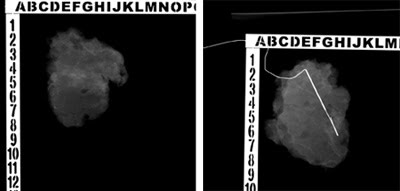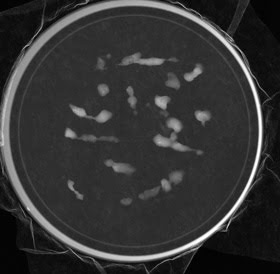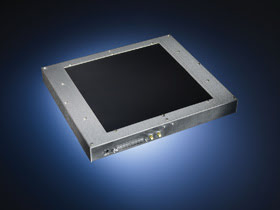Alana Achterkirchen, Rad-Icon Imaging, a Division of Dalsa Corp.
Technological advances in screening and
diagnostic breast imaging have enabled practitioners to deliver high-quality, accurate
health care services. Patients benefit from digital mammography because it is faster
and uses less radiation than the standard film-based mammogram. The images are seen
on a high-resolution monitor, allowing radiologists to see in greater detail, and
if an abnormality is found, there are many options for further evaluation.

(Left) A breast tissue sample is seen on the imaging grid. (Right) The needle is localized within a sample on the grid.
Advances in digital detector technology have made it possible
for radiology departments to make additional improvements in efficiency and effectiveness.
A complementary metal oxide semiconductor-based (CMOS) digital x-ray detector from
Rad-icon Imaging, a division of Dalsa Corp., helped one Connecticut hospital step
up its breast-imaging program.
When a mammogram indicates the presence of a breast abnormality
such as a suspicious solid mass or microcalcifications, stereotactic needle biopsy
is a nonsurgical method of assessing it. The area of concern is biopsied with a
vacuum-assisted needle. A surgeon can perform an excisional biopsy in an operating
room (OR) to remove the entire lesion. The lesion is then imaged to ensure that
the entire tumor has been removed, and the procedure is completed. Ideally, the
imaging process should happen as quickly as possible because the patient and surgeon
must wait in the OR for confirmation of a clear margin around the tissue specimen.

Stereotactic breast tissue cores are shown in a specimen tray. Images courtesy of Rad-icon Imaging.
Challenges arise in efficiently imaging a patient’s tissue
specimen if the radiography department is physically located in a different area
from the operating room. Even if there are multiple specimen radiography systems,
located far away, scheduling the timing to coincide with the procedure often can
be next to impossible in a busy hospital environment. Yet health care providers
with a focus on high-quality care can leverage technology to improve their services
and streamline their processes.
One hospital,1 in Stamford, Conn., strives to offer the latest
in imaging technology and services to provide patients with the highest quality
care. Its mammography department is staffed by three radiologists and seven technologists
and completes approximately 17,000 mammograms, 200 stereotactic breast biopsies
and 160 x-ray needle localization procedures annually. Its search for a specimen
radiography system began when it realized that its growing procedure volume warranted
a more efficient process for x-raying specimens than having an operating room aide
or technologist carry them to a mammography room downstairs – if one was even
available.

This SkiaGraph 8 x 8-in. CMOS x-ray panel from Rad-icon Imaging enables more efficient biopsies.
“Specimens were being held by our techs as they waited to
get into a mammography room to image them,” said the hospital’s chief
administrator of ambulatory imaging. “The time between removal of a specimen
and actual imaging was growing longer. Our surgeons actually were calling downstairs
before a procedure even began to hold open a mammo room. We were tying up a full
mammography unit waiting for the specimen to come down from the OR. There was a
big bottleneck, and our surgeons and radiologists were becoming unhappy.”
The hospital took steps toward acquiring a digital specimen radiography
system for real-time mobile digital imaging to increase the efficiency of its procedures.
It called Rad-icon Imaging’s partner Kub Technologies Inc. of Milford, Conn.,
for a demonstration of a mobile radiography system designed for imaging biopsy cores
and surgically excised tissue specimens. The system, called XPert 40, comes fully
equipped with a DICOM-compliant workstation for travel between OR suites and can
be wheeled around for easy mobility. Its compact size, user-friendly software and
standard AC power requirement allow it to be operated in most medical environments.
The core of the mobile radiography system is Rad-icon’s
detector, which has an active area measuring up to 8 x 10 in. The 16-bit contrast
resolution of the digital image sensor, combined with a 1.0-mA x-ray source output,
enables it to image even the tiniest microcalcifications in the largest specimens.
The company’s x-ray sensors’ resolution is as low as 48 μm, providing
high sensitivity and dynamic range, and hits the sweet spot in imaging small variances
in tissue samples where the contrast also is very small. The resulting digital images
are crisp and detailed enough to help physicians in busy medical practices who perform
many procedures a day.
Since its installation at the hospital in 2007, the mobile radiography
system has been used exclusively to image stereotactic breast biopsy material and
breast needle localization tissue. When suspicious tissue is extracted, cores or
specimens are walked a short distance across a hallway to the XPert imaging system
and placed in the machine. An image appears on a monitor within seconds, and the
hospital’s picture archiving communications system enables viewing in the
operating rooms almost instantaneously.
“We wanted ease of use, we wanted prompt service, and image
quality had to be top of the line,” said the chief administrator of ambulatory
imaging of the search for an optimal digital radiography system for the hospital.
“The images we’re getting are spectacular. When you’re looking
at microcalcifications that are smaller than a grain of salt, image quality is the
most important thing.”
The hospital calculates that members of the medical staff save
about 20 minutes for each stereotactic procedure because the new imaging system
is right across the hall. With about 20 procedures each month, the hospital saves
more than six hours, time that can be spent on other clinical matters, including
positioning patients for imaging or reading mammograms. Patients also spend less
time on the table under anesthesia, resulting in a more positive experience. And
because there are no waits to image specimens, there are no longer charges for extra
OR time.
“The mobile imaging system is just steps away,” said
the director of breast imaging. “We walk through a door, across a hallway,
and a few seconds later, we’ve got the image. There’s a significant
time savings over the way we imaged before. The image quality is great.”
The bottom line: At the hospital, the addition of a top-tier specimen
radiography system from a company that prides itself on instilling clinical confidence
by delivering high-quality digital images – and offering fast and effective
service and support – has resulted in a host of benefits. The medical staff
is grateful. “We know the unit will be up and running, that the radiologists
and surgeons are happy with the image quality, and that our techs are happy because
the unit is easy to learn and use. And we haven’t had one malfunction or mechanical
problem,” said the director of breast imaging. “I would recommend our
imaging system to anyone.”
Meet the author
Alana Achterkirchen is the director of business development and
marketing for Rad-icon Imaging, a Sunnyvale, Calif.-based division of Dalsa Corp.;
e-mail: [email protected].
Note
1. For privacy reasons, the names of the hospital and its employees
have been withheld.